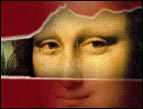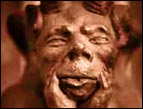
The Da Vinci Code promotes salvation through sex more effectively than its predecessors because it is an engaging novel. It teaches "sacred sex" not on the basis of Pagan philosophy ... but by invoking the authority of Jesus." |

Readers with little background in theology, history, or art may come away from The Da Vinci Code believing what it suggests about the Christian Church -- by Charles Colson. |

Author Eric Metaxas responds to Dan Brown's The Da Vinci Code from the viewpoint of C.S. Lewis' character Screwtape. Metaxas argues against the claims Brown's novel suggests in this letter addressed to Wormwood. |

Dr. James Garlow, one of the leading experts on the theology debate about The Da Vinci Code, has compiled a dictionary to help readers. |

"Our concern isn't really with Brown’s mistakes about medieval history, but the religious foundations on which his Grail theories are based." |
| |

Here are some specific examples of encounters, questions and topics you’re likely to hear when you use The Da Vinci Code as a witnessing tool -- and creative ways to respond to those questions and turn them into productive discussions. |
| |

The truth is that Brown's story has very little to do with truth. Instead, errors abound in The Da Vinci Code and not just about Christianity either. Author Richard Abanes examines this bestseller and highlights its misleading "facts." |
| |

Cultural commentator Phil Cooke writes, "Unless you’re ready to set up a permanent boycott office underneath the Hollywood sign, we need to consider a more effective way to share our faith with the culture." |
| |
Other Da Vinci Code Discussion Sites
|
|
|
|
| |
|
Recommended Books and Videos
|
|
|
|
| |
|
Da Vinci Code in the News
|
|
|
|
| |
|
Other Da Vinci Code Articles
|
|
|
|
| |
|
|
Differences Between Book & The Bible
Here are only a few of the errors represented as fact in Dan Brown's novel, The Da Vinci Code.
The Da Vinci Code says...
Jesus is a great man or prophet in the earliest historical sources but was later proclaimed divine at the Council of Nicaea.
|
 |
The Bible Says...
Jesus is called “God” (theos) 7 times in the New Testament. He is called “Lord” (kyrios) in the divine sense numerous times. No serious historian argues that these texts postdate the Council of Nicaea. |
The Da Vinci Code says...
The Dead Sea Scrolls along with the Nag Hammadi documents are the earliest Christian records. |
History Says...
The Dead Sea Scrolls are purely Jewish documents; there is nothing Christian about them. There is also no evidence any of the Nag Hammadi documents existed before the late second century A.D., with the possible exception of the Gospel of Thomas. |
The Da Vinci Code says...
“One particularly troubling theme kept recurring in the [Gnostic] gospels. Mary Magdalene. . . More specifically, her marriage to Jesus Christ" (p. 244).
|
 |
History Says...
The Gnostic Gospels, a collection of anonymous writings that blended pseudo-Christian ideas with esoteric spirituality, say nothing about Mary and Jesus being married. * |
The Da Vinci Code says...
“The Bible, as we know it today, was collated by the pagan Roman Emperor Constantine” (p. 231). |
History Says...
The Bible was not collated by Constantine, who died in 337 A.D. The Old Testament existed prior to even Jesus’s day. And the New Testament, although it started coming together by the end of the first century (about 90-100 A.D.), was not formalized until about 393-397 A.D. (after Constantine’s death). * |
The Da Vinci Code says...
“The royal bloodline of Jesus Christ has been chronicled in exhaustive detail by scores of historians” (p. 253).
|
 |
The Facts Say...
Following this comment about “historians,” Dan Brown lists four books written by various authors: Margaret Starbird, Michael Baigent, Richard Leigh, Henry Lincoln, Lynn Picknett and Clive Prince. But none of them are historians. Starbird has an M.A. in comparative literature and German. Baigent holds an undergraduate degree in psychology and is pursuing an M.A. in mysticism. Leigh is a novelist and short story writer. Lincoln gained notoriety as a BBC television personality and scriptwriter. And Picknett, along with Prince, is involved in occultism, the paranormal, and UFO studies. * |
The Da Vinci Code says...
Leonardo Da Vinci made the following comments about the New Testament: 1) “Many have made a trade of delusions and false miracles, deceiving the stupid multitude”; and 2) “Blinding ignorance does misled us. O! Wretched mortals, open your eyes” (p. 231). |
History Says...
These remarks have nothing to do with Leonardo’s views on scripture. His first comment, in context, is about alchemists who claimed that they could change lead into gold. His second comment, in context, refers to the foolishness of what he called men’s “own opinions,” “lascivious joys,” and “[v]ain splenour.” Brown completely misrepresented Leonardo’s writings to make it seem as if the great artist detested the Bible. * |
The Da Vinci Code says...
“The Jewish Tetragrammaton YHWH—the sacred name for God—in fact derived from Jehovah, an androgynous physical union between the masculine Jah and the pre-Hebraic name for Eve, Havah (p. 309).
|
 |
History Says...
YHWH was not derived from “JEHOVAH.” The term actually predates “JEHOVAH” by thousands of years. Brown, in fact, has it backwards—i.e., “JEHOVAH” was derived from YHWH. It is merely the sixteenth century Latinized form of YHWH with “a,” “o” and “a” (the vowels from adonai, “my Lord”) inserted between each consonant (Latinizing the word changed the “Y” and “W” to “J” and “V.”). As for the word Havah, there is nothing “pre-Hebraic” about it. This is simply “Eve” in Hebrew and it appears in the Old Testament. * |
The Da Vinci Code says...
Constantine “commissioned and financed a new Bible, which omitted those gospels that spoke of Christ’s human traits and embellished those gospels that made him godlike. The earlier gospels were outlawed, gathered up and burned” (p. 234). |
History Says...
First, there was no “new” Bible commissioned by Constantine. The emperor simply requested that Eusebius (the Bishop of Carthage) make fifty copies of the already existing and widely accepted scriptures. Second, no evidence suggests that Constantine or anyone else “embellished” Matthew, Mark, Luke, or John. Third, there were no gospels burned by Constantine. Although some texts written by Arius were burned, none of them were gospels. Fourth, there were no gospels “earlier” than Matthew, Mark, Luke or John. Finally, as previusly noted, the gospels in our Bible clearly depict Christ’s “human traits,” which is consistent with the Christian teaching that Jesus was 100% deity as well as 100% human. * |
The Da Vinci Code says...
Sexual union between man and woman through which each became spiritually whole had been recast as a shameful act by the Church to 'reeducate' the pagan and feminine-worshipping religions.
|
 |
The Bible Says...
The marriage bed is treasured and honored as pure (Heb. 13:4). Sexual activities and pleasure are normal, expected, and encouraged within a marriage. Sexual union is a divine moment for a husband and a wife -- a representation of the image of God that defines us. God established boundaries around sex to protect it and maximize its joy. * |
The Da Vinci Code says...
“[A]ny gospels that described earthly aspects of Jesus’ life had to be omitted from the Bible” (p. 244). |
The Bible Says...
The gospels in our New Testament present many “earthly aspects” of Christ’s life such as his physical frailties (hunger, fatigue, death); emotions (anguish, outrage, love); and relational interactions (with his mother, friends, and followers). * |
The Da Vinci Code says...
Leonardo’s worship of the goddess and the feminine can be seen in his Mona Lisa painting. That name comes from two Egyptian deities: the god Amon and the goddess Isis, whose “ancient pictogram was once called L’ISA. The title Mona Lisa, then, is really “an anagram of the divine union of male and female (p. 121).
|
 |
History Says...
Leonardao Da Vinci did not even name this particular painting. None of his works, in fact, were titled by him. The Mona Lisa was catalogud by author Giorgio Vasari in his book Lives of the Artists (1550). It was he who first called it the Monna Lisa, which in English was shortened to Mona Lisa. It simply means Madame Lisa, and refers to the likely subject: Lisa Gherardini del Giocondo, the wife of Francesco del Giocondo. * |
| |
|
Related article by Richard Abanes: The Truth, Dan Brown, and The Da Vinci Code
* Excerpt from The Truth Behind The Da Vinci Code by Richard Abanes |
|
|
